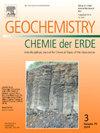tuzta低硫化金成矿的石英结构、矿物化学和流体包裹体特征及其形成意义
IF 2.9
3区 地球科学
Q2 GEOCHEMISTRY & GEOPHYSICS
引用次数: 0
摘要
在主石英脉(MQV)内的tuzta本文章由计算机程序翻译,如有差异,请以英文原文为准。
Quartz textures, mineral chemistry and fluid inclusion features of Tuztaşı low-sulphidation Au mineralization: Implication to it's formation
The Tuztaşı gold mineralization, within the Main Quartz Vein (MQV), is located within the amphibolite schist of the Sütüven Formation along a structural zone trending K50D. The vein is inclined approximately 40° to the northeast, exhibits a thickness ranging from 3 to 8 m with 2 km lenght. Gangue minerals within the vein primarily consist of quartz, chalcedony, and opal. In MQV, crustiform, feathery, colloform textures indicating boiling and massive chalcedony, comb, textures in restricted zones, as well as replacement textures and brecciation in later stages have been identified.
In the amphibolite, the host rock around the MQV, while weak argillic alteration developed represented by quartz, montmorillonite, kaolinite mineral associations, this alteration is surrounded by propylitic alteration represented by quartz, albite, orthoclase, chlorite, calcite, and ankerite mineral associations.
LA-ICP-MS studies on quartz of the MQV revealed the gold values up to 4.02 ppm and silver values reaching 100 ppm, predominantly enriched in secondary voids (vugs) and iron-rich fracture zones. SEM-EDX analyses of gold-bearing quartz have identified chromite, chalcopyrite, native platinum, and Ni-Fe-Cr alloy, suggesting interactions with ore-forming fluids potentially originating from the mafic-ultramafic levels of the Sütüven Formation and Çetmi Melange.
Fluid inclusion studies show that liquid-rich inclusions dominate in MQV, but vapour-rich inclusions also occur together in genetically. According to microthermometric data, Th values of quartz vary between 186 and 330 °C, but the majority of the data (89 %) fall within the 180–260 °C range (aver. 213 °C, n = 104). The salinity of the fluids ranges from 0.18 % to 2.74 %, with an average of 0.63 % wt. NaCl equivalent. The dominant temperature range (180–260 °C) corresponds to a salinity of 0.35 wt% NaCl equivalent. An average Th (221 °C) and salinity (0.63 % wt. NaCl equivalent) values are resemble typical of low-sulphidation gold deposits.
Oxygen isotope (δ18O) data of quartz from the MQV, ranging between 6.6 ‰ and 8.6 ‰, indicating a meteoric origin for the fluids. This is indicated by the δ18OSMOW values of waters in equilibrium with quartz, falling between δ18Owater − 6.8 ‰ and 0.7 ‰.
Collevtively, fluid inclusions, oxygen isotope data, quartz textures in MQV and alteration features are evaluated together, the Tuztaşı Au mineralization exhibits the characteristics of a low-sulphidation type Au deposit rather than an orogenic type Au deposit.
求助全文
通过发布文献求助,成功后即可免费获取论文全文。
去求助
来源期刊

Chemie Der Erde-Geochemistry
地学-地球化学与地球物理
CiteScore
7.10
自引率
0.00%
发文量
40
审稿时长
3.0 months
期刊介绍:
GEOCHEMISTRY was founded as Chemie der Erde 1914 in Jena, and, hence, is one of the oldest journals for geochemistry-related topics.
GEOCHEMISTRY (formerly Chemie der Erde / Geochemistry) publishes original research papers, short communications, reviews of selected topics, and high-class invited review articles addressed at broad geosciences audience. Publications dealing with interdisciplinary questions are particularly welcome. Young scientists are especially encouraged to submit their work. Contributions will be published exclusively in English. The journal, through very personalized consultation and its worldwide distribution, offers entry into the world of international scientific communication, and promotes interdisciplinary discussion on chemical problems in a broad spectrum of geosciences.
The following topics are covered by the expertise of the members of the editorial board (see below):
-cosmochemistry, meteoritics-
igneous, metamorphic, and sedimentary petrology-
volcanology-
low & high temperature geochemistry-
experimental - theoretical - field related studies-
mineralogy - crystallography-
environmental geosciences-
archaeometry
 求助内容:
求助内容: 应助结果提醒方式:
应助结果提醒方式:


